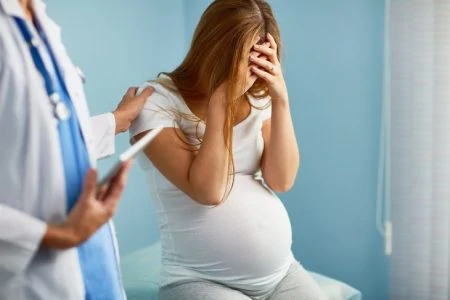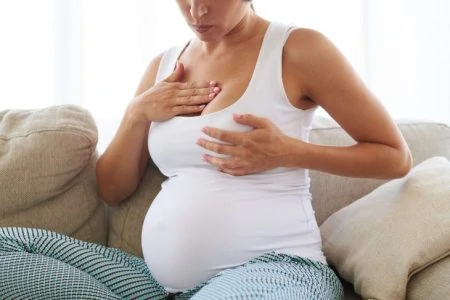Are you pregnant and worried because your baby bump isn’t showing yet? Are you wondering what factors affect the timing of when you start showing?
All women are different, and you will likely show at a different time than other moms you know. This shouldn’t cause you to worry.
Many factors contribute to when your baby bump will make its presence known. By becoming aware of these factors, you can understand why you might not be showing yet, which should relieve any worries you may have.
Key Takeaways
- Baby bumps typically show between 16 and 20 weeks of pregnancy, but can vary based on factors such as height, weight, age, fitness level, and previous pregnancies.
- Pregnant women with a higher fitness level and stronger abdominal muscles may show their baby bump later.
- Mothers expecting multiples, such as twins or triplets, may start showing as early as six weeks into pregnancy.
- If you have concerns about your baby bump’s appearance, consult your doctor for reassurance or to address potential issues.
- When Will I Start Showing?
- When Will I Begin To Show if I Am Overweight?
- How Is a Pregnancy With Multiples Different?
- Will I Show Sooner if I Have Already Been Pregnant?
- How Does Your Height Factor In?
- Your Fitness Level Can Affect Your Bump
- I’m Not Showing, so Why Don’t My Clothes Fit?
- If You Have Concerns
- FAQs
When Will I Start Showing?
It’s typical for a woman to start showing between 16 and 20 weeks of pregnancy (1). If you show before this time or after, that is usually fine too.
Moms sometimes confuse bloating with showing. So if your pants seem to stop fitting shortly after you take that pregnancy test, bloating is most likely the culprit.
Numerous factors can contribute to when your baby bump will become noticeable in your pregnancy. All pregnancies are unique, so some women may show way earlier or later than others. The bump may even become visible at a different time than it did in a woman’s previous pregnancy.
Here is a glimpse at some factors that contribute to your baby bump’s visibility:
- Height.
- Weight.
- Age.
- Fitness level.
- Uterus position.
- Expecting multiples.
- Previous pregnancies.
- Previous abdominal surgeries.
Once your little bump makes its appearance, be sure to document this journey. You will love having the opportunity to look back on this priceless experience.
If you’re carrying one baby, you can usually feel the top of the uterus above the pubic bone at about 13-14 weeks. If you are carrying twins or higher-order multiples, this may happen earlier. You may not show at this time, but the doctor or midwife can usually feel the uterus on examination, even if you are overweight.Belly bump measurements will usually start around 20 weeks. In most women, this is when the doctor can estimate gestational age by measuring the height of the “top” of your uterus, the so-called fundus. Still, keep in mind that the accuracy of this method depends on many factors, so it is just one of the methods we use to check that you and your baby are on track with expected growth measurements.
Editor's Note:
Dr. Irena Ilic, MDWhen Will I Begin To Show if I Am Overweight?
Some women are afraid they will just look larger and never develop that obvious pregnant belly. Unfortunately, this is the case for some moms, and it depends on your body type. Some women look pregnant earlier in their pregnancy if all their new weight gain is in the abdominal region.
No matter your pre-pregnancy weight, you will probably gain at least 20 more pounds during your pregnancy. It is essential that you eat a healthy and balanced diet and monitor your weight gain with your health care provider. The expected weight gain depends on your body mass index before pregnancy and whether you are expecting one or more babies.
Weight gain within the recommended range is a sign of a healthy pregnancy (2). However, too much weight gain can lead to complications during labor, increasing the risk for hypertension and gestational diabetes mellitus. It can also make it harder for you to lose weight after delivery and lead to having even more weight in any subsequent pregnancies (3).
Health Tip
While you are pregnant, you should engage in 150 minutes of moderate-intensity aerobic activity per week. Spread it out throughout the week as convenient for you. This means, for example, brisk walking for 10 minutes twice a day. Moderate activity is intense enough that you can’t sing while doing it, but you can carry on a conversation. Just make sure you avoid risky physical activities such as contact sports, and after the first trimester, avoid exercises that involve lying on your back (4).
One thing that can prevent people from realizing you are pregnant is if you choose to wear your typical wardrobe rather than maternity clothes. Maternity clothes emphasize your pregnant belly and can make it more apparent that there is a tiny human growing in there (5).
It’s possible you could end up looking very pregnant, or you may just look larger than before.
Don’t let the way your pregnant belly looks get you discouraged — it’s what’s on the inside that matters. No matter the shape or distinction of your baby bump, the end result is what matters — that beautiful baby. Instead of worrying about the appearance of your bump, try thinking proactively, and take steps that can help you prevent and minimize stretch marks.
How Is a Pregnancy With Multiples Different?
Mothers expecting more than one baby will have more significant body changes than a mother carrying a singleton.
Many moms suspect they might be pregnant with multiples when their belly growth seems to be relatively rapid. But since this can also be due to bloating, which is pretty common in pregnancy, you’ll still need an ultrasound to confirm that you’re pregnant with multiples.
A multiples pregnancy can begin showing as early as six weeks. This is a significant difference from the 12-16 weeks associated with a singleton.
Your body knows it is pregnant with multiples, so it has to be prepared to accommodate two embryos. Your uterus will have to stretch much more than it would when carrying one baby, so it is not unlikely for you to look like you are much further along than you are. If you are carrying multiples, you will probably appreciate all the benefits that maternity belts and belly bands can give you both during — and especially after — your pregnancy.
More than one-half of women carrying twins. and almost all women pregnant with triplets or more, actually give birth before 40 weeks because of multiple factors, including decreased space for their little ones to grow.
Will I Show Sooner if I Have Already Been Pregnant?
If you have already experienced pregnancy, chances are you will notice your baby bump significantly sooner than you did in your first pregnancy.
The reason you may show sooner is that your first pregnancy has already “prepped” your body for what is to come. Your previous pregnancy stretched your abdominal and uterine muscles, making them more pliable for your new pregnancy (6).
Your uterus also does not shrink back down to the original size it was before you ever became pregnant, so it has a jump start to begin growing in your next pregnancy (7).
If you have already been pregnant at least once, you will likely show about one month earlier in your next pregnancy.
Not only will you start showing sooner, but you will feel your baby move sooner than you did in your first pregnancy, and labor probably won’t last as long — yay!
How Does Your Height Factor In?
Your height plays a rather significant role in the timing of your baby bump. Your baby needs room to grow, and tall women seem to have a lot more space.
One could say that short women are compact, so their babies only have one way to grow — out. The issue really comes down to the amount of space below the rib cage.
A taller woman has significantly more space under her ribcage, so the baby doesn’t have to grow outward as much as the baby of a shorter woman.
Don’t Sweat It
So, even if you are months into your pregnancy, don’t be concerned about people commenting on how small you are. As long as your doctor has no worries and your baby is growing on schedule, the prominence of your bump doesn’t matter.
Don’t get discouraged if you don’t have the large bump you desire. Chances are you are much more comfortable than a shorter woman with her basketball on full display.
Pregnancy tends to be somewhat easier for taller women because it doesn’t strain their bodies nearly as much. Still, because of the extra space their babies have for growing, these infants sometimes have a higher birth weight. This can lead to labor complications and presents a risk factor for some chronic diseases like hypertension later in the child’s life. Therefore, tall pregnant women should consult their health care providers about the recommended level of physical activity and avoid a sedentary lifestyle during their pregnancy (8).
Whether you are tall or short, make the most of your pregnancy, and appreciate that growing life inside of you. Remember, just like with every woman, every pregnancy and every bump is unique.
Your Fitness Level Can Affect Your Bump
It seems as if it only makes sense for thin, in-shape women to develop a baby bump rather early. However, these women are often able to hide their bump much longer.
Although being thin can cause your bump to become more prominent, those who frequently work out have an extra layer of protection.
A woman with defined abdominal muscles will be able to mask her baby bump because her abs will hide her uterus from view. Some extremely fit pregnant mothers barely show even a couple of weeks before delivery. This is perfectly normal, as long as the doctor judges that a woman’s pregnancy weight gain is within her recommended range.
This is an extreme case, of course, but if you have strong abdominal muscles, it’s possible your bump will make its appearance later.
Age and Abdominal Muscles
Many young mothers seem to show significantly later than middle-aged mothers. This all has to do with the abdominal muscles once again. A younger mother usually has a tighter stomach, which can hide the uterus for longer periods.
Tighter abdominal muscles are also one of the reasons younger mothers tend to “bounce back” quicker after delivery.
I’m Not Showing, so Why Don’t My Clothes Fit?
Some expectant moms will begin to notice that their clothes are fitting tighter even though they don’t have the slightest hint of a baby bump.
If your clothes aren’t fitting, and you don’t have a bump, you are likely experiencing early pregnancy bloating. Your pregnancy hormones can cause this bloating to occur, and it should not be mistaken for a baby bump.
It is possible your clothes will fit one day and not the next, depending on the severity of your bloating.
Your body is changing every day, trying to accommodate your little one. Cherish every moment; your belly will pop soon enough!
In nine months, you aren’t going to be worried about whether you started showing too early or too late. You are just going to care about that special baby you’re holding in your arms.
If You Have Concerns
It is not crazy to question many milestones on your journey to motherhood. You know your body best, so if you have any worries, you should take them seriously.
It is beneficial to mark relevant pregnancy-related events in a journal or with an app, and your health care provider might even instruct you to do so. This may help you compare your current with your past and previous pregnancies and give your doctor some valuable information. If you believe your belly ‘s growth seems extremely advanced or behind, contact your doctor.
Your doctor will either reassure you and give you peace of mind, or you may be able to catch a problem early on. There are different reasons why belly growth can be advanced or behind, including being pregnant with multiples, having too much or too little amniotic fluid, gestational diabetes, hypertension, inadequate diet, substance abuse, or smoking.
Never be afraid to ask questions. Your doctor has probably heard just about everything, so don’t hesitate to reach out, as there is no such thing as a silly question when it comes to health matters. You are responsible for two lives now, and you deserve all the positive validation you can get!









